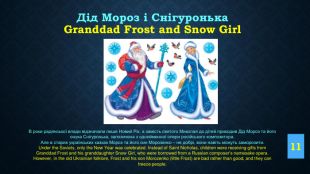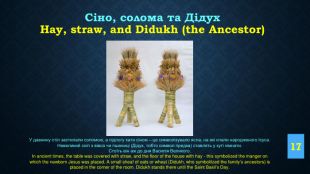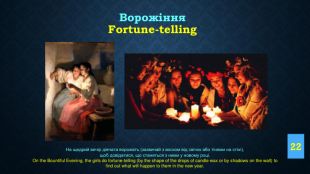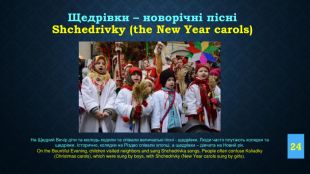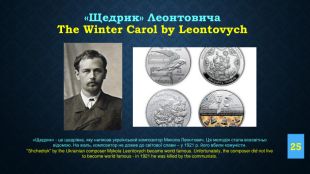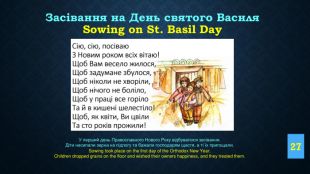Новорічні та різдвяні традиції України (New Year and Christmas traditions in Ukraine)





























2 Застереження. Disclaimer. Ця презентація – про традиції новорічних свят в Україні, від Святого Миколая і до Святого Василя. Як ви можете побачити з назв, вони тісно пов’язані з християнством, яке довгий час було та є переважною релігією серед українців. Як Україна, так і Канада поважають свободу віри та совісті. Презентація не має на увазі просування релігійної віри, а лише розповідь про традиції, щоб учні розуміли, звідки вони походять, і який зміст прихований в тих чи інших обрядах. This presentation is about the New Year holiday traditions in Ukraine, from Saint Nicholas’ Day to Saint Basil’s Day. As you can see from the names, they are closely related to Christianity, which has long been and is the predominant religion among Ukrainians. Both Ukraine and Canada respect freedom of belief and conscience. The presentation is not intended to promote religious faith, but only to tell about traditions so that students understand where they come from and what meaning is hidden in certain rituals.
3 Зимові свята в Україні і в КанадіWinter holidays in Ukraine and in Canada. В Канаді досить рано починають прикрашати будинки перед Різдвом – дехто починає робити це у листопаді, одразу після Геловіну. Різдво відзначають 24 грудня у сім’ї, і вважають, що вночі Санта-Клаус приносить подарунки. За Різдвом йде святковий тиждень і свято Нового Року. В Україні багато століть зимові свята були досить довгими. Вони починалися з зимового посту, потім – свято Святого Миколая, потім за три тижні – Різдво, потім Новий Рік (Василів День). Під час цих свят було багато цікавих обрядів (колядки, щедрівки, водіння кози, Маланка, посівання тощо). У комуністичні часи святкували лише Новий Рік. Але останні 30 років в Україну повертаються всі старовинні традиції. In Canada, people start decorating their houses quite early, sometimes a few weeks before Christmas - some start doing it in November, right after Halloween. Christmas Eve is celebrated on December 24 in the family, and it is believed that Santa Claus brings gifts at night. Christmas is followed by a festive week and a New Year's holiday. In Ukraine, winter holidays were quite long for many centuries. They began with the winter fast, then the feast of St. Nicholas, then in three weeks - Christmas, then the New Year (St. Basil's Day). During these holidays, there were many interesting rituals (carols, giving gifts, goat processions, Malanka, sowing, etc.). In Communist times, only the New Year was celebrated. But in the last 30 years, ancient traditions are returning to Ukraine.
4 Два календарі, два Різдва. Two calendars, two Christmases. Різдво в світі відзначають у ніч з 24 на 25 грудня. Але до минулого року в Україні і Різдво, і інші релігійні свята відзначали на 13 днів пізніше. Чому так?Christmas Eve is celebrated on the night of December 24-25. However, until last year Christmas and other religious holidays were celebrated 13 days later in Ukraine. How did it happen?
5 Юліанський календар. The Julian Calendar2000 років тому римський імператор Юлій Цезар запровадив календар, який на його честь зветься юліанським. Кожні 140 років календар відставав на один день. Цим календарем донедавна користувалися церкви в Україні.2000 years ago the Roman emperor Julius Caesar introduced a calendar, which was named Julian in his honor. Approximately every 140 years, the Julian calendar falls one day behind. This calendar was used by Christian churches in Ukraine
6 Григоріанський (новоюліанський) календар. The Gregorian (neo-Julian) Calendar. Країни світу вже давно перейшли на новий календар (в Україні він діє з 1918 року). Але християни України перейшли на нього лише цього, 2023 року. Як ви думаєте, чому?Most countries of the world adopted the new corrected calendar long ago. Ukraine adopted it in 1918. However, Christians of Ukraine only adopted it this year – why do you think it took them so long?
7 День Святого Миколая. Saint Nicholas’ Day. Святий Миколай приходить до українських дітей 6 грудня (за старим календарем – 19 грудня). В Канаді його звуть Санта-Клаус, і він приходить пізніше, лише на Різдво. Saint Nicholas brings gifts to Ukrainian kids earlier than in Canada, on December 6 (or 19 in the old calendar). In Canada, he is nicknamed Santa Claus, and comes later, only on Christmas.
8 Святий Миколай. Saint Nicholas. Близько 1700 років, у часи Римської імперії, жив грек Миколай, який був пастирем місцевої християнської громади у місті Мира (на півдні сучасної Туреччини). Він придумав влаштовувати добродійні вчинки: громада збирала кошти, а потім давала подарунки або гроші у бідним, або підкидала їх у вікна. About 1700 years ago, a Greek named Nicholas lived in the ancient Roman Empire. He was the priest of the local Christian community in the city of Myra (today’s southern Turkey). He organized charitable acts: the community collected funds, and then distributed gifts or money to the poor, or threw them through the windows.
9 Як Миколай став Санта-Клаусом. How Saint Nicholas became Santa Claus. Миколая шанували як святого. Пізніше він став популярним казковим героєм; люди вірили, що він щороку повертається з небес, щоб обдарувати тих, хто на нього чекає. Сучасний образ Санта-Клауса (це те ж саме, що Святий Миколай, але голландською мовою) запропонувала компанія «Кока-Кола». Санта носить одяг у фірмових кольорах «Кока-Коли». Nicholas was revered as a Christian saint. Later he became a popular fairy-tale hero; people believed that he returns from heaven every year to give gifts to those who wait for him. The modern image of Santa Claus (from “Sinterklaas”, which means the same as St. Nicholas in Dutch) was designed by Coca Cola. Santa wears a costume in the branded colors of Coca Cola.
10 Хода з чортом. The procession with the devil. На Святого Миколая влаштують ходу з чортом. Врешті-решт чорта проганяють. Також існував звичай неодмінно віддавати борги до Святого Миколая. On St. Nicholas Day, villagers arrange a procession, where someone gets dressed up as the devil. In the end, St. Nicholas chases away the devil (thus showing that good always wins). It was customary to pay back debts before St. Nicholas Day without fail.
11 Дід Мороз і Снігуронька. Granddad Frost and Snow Girl. В роки радянської влади відзначали лише Новий Рік, а замість святого Миколая до дітей приходив Дід Мороз та його онука Снігуронька, запозичена з однойменної опери російського композитора. Але в старих українських казках Мороз та його син Морозенко – не добрі, вони навіть можуть заморозити. Under the Soviets, only the New Year was celebrated. Instead of Saint Nicholas, children were receiving gifts from Granddad Frost and his granddaughter Snow Girl, who were borrowed from a Russian composer’s namesake opera. However, in the old Ukrainian folklore, Frost and his son Morozenko (little Frost) are bad rather than good, and they can freeze people.
12 Пилипів піст. St. Philip’s Fast40 днів до Різдва селяни тримали піст. Під час посту не можна було вживати м’ясо, жирні страви та яйця. Порушувати піст священик дозволяв лише хворим.40 days before Christmas, villagers fasted. During the fast, you were not allowed to eat meat, fatty food and eggs, but if you were ill the priest could give you an exception.
13 Святий Вечір. The Holy Evening. Вечір перед Різдвом в Україні (24 грудня, раніше 6 січня) зветься Святий Вечір. Це сімейне свято. Історично, це було свято народження Ісуса Христа. Christmas Eve in Ukraine is celebrated on the evening of December 24 (earlier January 6), and is known as The Holy Evening. This is a family holiday. Historically, it was the celebration of the birth of Jesus Christ.
14 Вечеря. The Dinner. Святий Вечір проходить за старовинним обрядом. До Різдвяної Вечері збирається вся родина, коли на небі зійде Зірка. Господар дому першим сідає за стіл і запалює свічку, яка символізує безсмертя та світло. The Holy Evening is celebrated according to the ancient rite. The whole family gathers for Christmas Dinner, when stars appear in the sky. The head of the family is the first to sit down at the table and light a candle, which symbolizes immortality and light.
15 Кутя. Kutia. Головною різдвяною стравою є кутя, яку куштують першою. Її готують переважно з пшеничної крупи з додаванням родзинок, меду та маку. Проте кожна господиня чи господар по-своєму модифікує рецепт куті й, в такий спосіб, намагається його удосконалити. The main Christmas dish is kutia, which is served first. It is prepared mainly from wheat groats with the addition of raisins, honey and poppy seeds. However, each cook modifies the recipe in their own way and tries to improve it.
16 Ялинка та Віфлеємська зірка. The Christmas Tree and the Star of Bethlehem. Канадці прикрашають ялинку на Різдво (24 грудня). Українці прикрашають її невдовзі до Нового року. Ялинку прикрашають іграшки, а на її вершині – Віфлеємська зірка. Canadians decorate the Christmas tree shortly before Christmas (December 24). Ukrainians decorate it shortly before New Year. The tree is decorated with toys, and features the Star of Bethlehem on its top.
17 Сіно, солома та Дідух. Hay, straw, and Didukh (the Ancestor)У давнину стіл застилали соломою, а підлогу хати сіном – це символізувало ясла, на які клали народженого Ісуса. Невеликий сніп з вівса чи пшениці (Дідух, тобто символ предка) ставлять у куті кімнати. Стоїть він аж до дня Василія Великого. In ancient times, the table was covered with straw, and the floor of the house with hay - this symbolized the manger on which the newborn Jesus was placed. A small sheaf of oats or wheat (Didukh, who symbolilzed the family’s ancestors) is placed in the corner of the room. Didukh stands there until the Saint Basil’s Day.
18 Колядки. Koliadky (Christmas Carols)Вранці після Святого Вечора наступає Різдво, на яке діти та молодь влаштовують різдвяну ходу. Перед собою вони несуть Віфлеємську зірку та великого Дідуха. Вони співають колядки – пісні на честь народження Ісуса, а люди їх пригощали. Раніше колядки співали лише хлопчики. On Christmas morning, children and youth organize a Christmas procession. They carry the Star of Bethlehem and the Didukh in front of them. They sing Koliadky (i.e. carols to honor the birth of Jesus), and people give them sweet treats. Traditionally, only boys sang Christmas carols.
19 Вертеп. Vertep (the Christmas theatre)Наступного дня після колядування, а іноді і в той самий день, молодь влаштує вертеп – театр на біблійні теми.Іноді актори – це люди, а іноді це ляльковий театр. The next day after the caroling, and sometimes on the same day, young people would arrange a Vertep - a theater on biblical themes. Sometimes the actors are people, and sometimes it's a puppet show.
20 Шопка. Shopka (the Nativity Scene)На заході України на стіл у хаті виставляли шопку – сцену народження Ісуса.Іноді робили великі шопки – не в хатах, а у публічних місцях, для всього селища. In Western Ukraine, a Shopka (Nativity Scene) was placed on the table. Sometimes people created really large Nativity Scenes, which were displayed not in houses but in public places (town squares etc.)
21 Щедрий Вечір. The Bountiful Evening. Вечір перед Православним Новим Роком (з 12 на 13 січня) зветься Щедрий Вечір. На нього знов готують кутю, як на Різдво, але «щедру» (вона містить більше смачного), бо піст закінчився. The evening before the Orthodox New Year (from January 12 to 13) is called Bountiful Evening. Kutia is prepared again, as at Christmas, but it is called “bountiful" because the fast is over.
22 Ворожіння. Fortune-telling. На щедрий вечір дівчата ворожать (зазвичай з воском від свічок або тінями на стіні), щоб довідатися, що станеться з ними у новому році. On the Bountiful Evening, the girls do fortune-telling (by the shape of the drops of candle wax or by shadows on the wall) to find out what will happen to them in the new year.
23 Водіння кози. Goat procession. Один з новорічних обрядів – водіння кози. Один з учасників ходи одягався козою та бешкетував. Після того, як козу один раз вдаряли палицею, вона прикидалася мертвою, але учасники викликали «лікаря», який приводив козу до тями. One of the New Year rituals is the Goat Procession. One of the participants gets dressed up as a goat and brawls. When another participant hits it once with a stick, it pretends to be dead, but others call a "doctor" who brings the goat back to consciousness.
24 Щедрівки – новорічні пісніShchedrivky (the New Year carols)На Щедрий Вечір діти та молодь ходили та співали величальні пісні - щедрівки. Люди часто плутають колядки та щедрівки. Історично, колядки на Різдво співали хлопці, а щедрівки – дівчата на Новий рік. On the Bountiful Evening, children visited neighbors and sang Shchedrivka songs. People often confuse Koliadky (Christmas carols), which were sung by boys, with Shchedrivky (New Year carols sung by girls).
25«Щедрик» Леонтовича. The Winter Carol by Leontovych«Щедрик» - це щедрівка, яку написав український композитор Микола Леонтович. Ця мелодія стала всесвітньо відомою. На жаль, композитор не дожив до світової слави – у 1921 р. його вбили комуністи."Shchedryk" by the Ukrainian composer Mykola Leontovych became world famous. Unfortunately, the composer did not live to become world famous - in 1921 he was killed by the communists.
27 Засівання на День святого Василя. Sowing on St. Basil Day. У перший день Православного Нового Року відбувалося засівання. Діти насипали зерна на підлогу та бажали господарям щастя, а ті їх пригощали. Sowing took place on the first day of the Orthodox New Year. Children dropped grains on the floor and wished their owners happiness, and they treated them.
28 Спалення Дідуха. Burning of Didukh. Коли закінчувалися новорічні свята, приходив час палити Дідуха. Вважалося, що Дідух символізував душі предків, які приходили на свято до родичів, а після свят їм приходив час повертатися на небо. When the New Year holidays ended, it was time to burn Didukh (the Ancestor). It was believed that Didukh symbolized the souls of ancestors who came to visit their relatives for a holiday, and after the holidays it was time for them to return to heaven.
29 Джерела. Sourceshttps://donnaba.edu.ua/storinka-biblioteky/538-tradytsii-sviatkuvannia-rizdva-v-ukraini https://life.nv.ua/ukr/art/svjatij-vechir-koljadki-i-koloritnij-vertep-traditsiji-svjatkuvannja-rizdva-v-ukrajini-404548.html https://ukrzoloto.ua/uk/blog/rizdviani-tradytsii-v-ukraini-istoriia-pro-simeine-sviato/


про публікацію авторської розробки
Додати розробку











